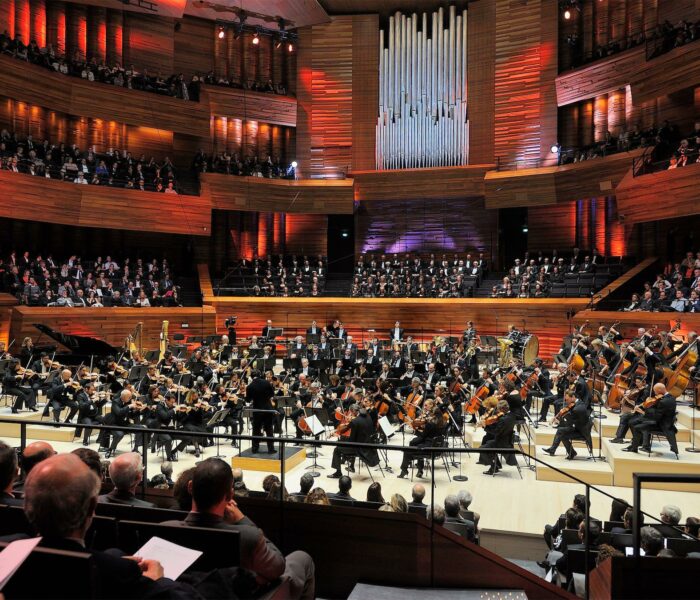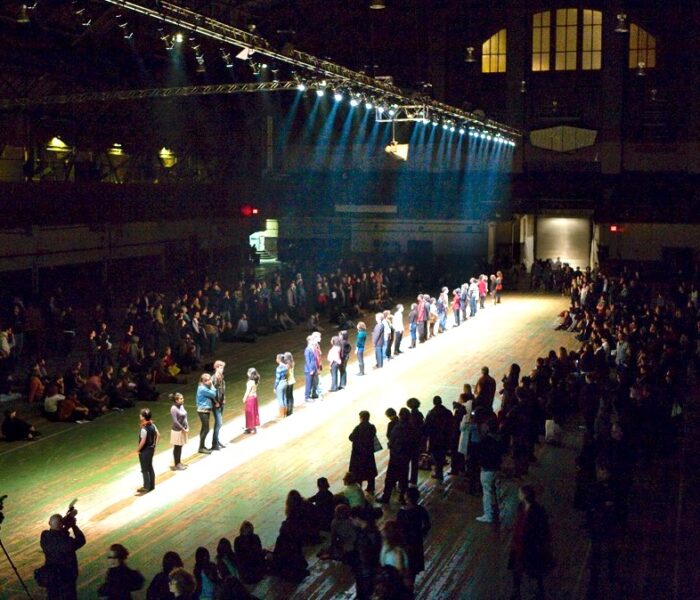Compositeur, performer, artiste visuel et scénariste français, Léo Collin travaille à Zurich et monte des projets, petits et grands formats, avec sa compagnie Kollectiv International Totem. Entre musique et théâtre, installation, performance et dimension participative, le collectif mise sur la transversalité des genres, les ressorts de la technologie et une bonne dose d’imagination pour nous faire voir et écouter autrement.
Léo Collin, votre compagnie Kollektiv international totem est encore peu connue en France. Pouvez-vous nous la présenter?
La compagnie est basée à Zurich, ville qui nous a accueillis dès nos débuts en 2015 et nous permet de vivre de notre activité artistique. Il est vrai que l’on s’exporte assez peu ; notre présence au festival Archipel de Genève dont nous avons fait l’ouverture avec Corals, une station-service est presque une exception dans le flux de nos activités.
Quelques mots peut-être sur l’appellation de votre compagnie?
Nous sommes huit permanents, venus des quatre coins de la terre ; je voulais que l’appellation mette l’accent sur cette ouverture au monde, aux langues et aux cultures ; j’ai donc choisi trois termes qui, d’une façon ou d’une autre, désignent la même chose : un rassemblement de personnes qui mettent leur énergie et leurs idées en commun, qui vibrent ensemble mais ne sont pas du même coin. Nous venons tous de la musique et jouons tous d’un instrument (saxophone, cor, flûte, piano, percussion, etc.). Pour autant, nous faisons du théâtre expérimental où la musique, disons l’art sonore, infiltre notre propos.
Vous êtes pianiste et compositeur français. Quel a été votre parcours?
À l’origine, je suis plutôt un visuel! J’ai passé le baccalauréat d’Arts appliqués à Besançon puis à Marseille et j’ai basculé après coup dans l’univers musical. J’ai commencé tardivement le piano et découvert le grand répertoire classique au Conservatoire à Rayonnement Régional de Lyon, une période d’apprentissage intensif lié à des études de composition (électroacoustique et instrumentale) qui semblaient me convenir davantage. J’ai finalisé ma formation de compositeur à la HEM de Genève avec Michael Jarrell et fréquenté les Cours d’été de Darmstadt et le festival de Donaueschingen, ces lieux mythiques de la musique contemporaine où l’on peut embrasser toutes les courants de la création sonore, y compris la musique conceptuelle. Je décide alors d’apprendre l’allemand et viens m’installer à Zurich, une ville qui possède l’une des plus grandes académies d’Europe (Zürcher Hochschule der Künste/université des Arts de Zurich), réunissant design, cinéma, beaux-arts, musique, danse, théâtre, transdisciplinarité et communication des arts et du design : un lieu qui valorise, pour moi, ce croisement des pratiques et ce décloisonnement des genres que je recherche.
On a assisté à la Maison communale de Plainpalais de Genève à une “installation performative” de quatre heures qui met en scène des acteurs/musiciens, un décor, de la vidéo, de l’électronique et des smartphones, une de vos réalisations les plus ambitieuses à ce jour. Quelle a été la genèse de Corals, une station-service?
C’est une longue aventure qui s’est étirée sur deux voire trois années ; l’idée de la station- service m’est venue d’une lecture d’un goût douteux (Guerrier pacifique de Dan Millman) qui m’avait fascinée à l’adolescence : on y raconte la présence, dans une station-service, d’un gourou qui transcende la banalité des lieux et sort ses occupants de leurs tâches et gestes quotidiens pour les faire accéder à une autre réalité, plus exaltante et belle. J’ai lu par la suite beaucoup d’histoires sur les stations-service pour alimenter la mienne. À travers les figures des quatre employés de la boutique, la caissière, le technicien de surface, l’agent de sécurité et le dépanneur, tous dans une situation précaire, je me suis intéressé au phénomène de stéréotypie : ces gestes et actes automatiques liés à un contexte particulier que chacun des personnages accomplit sans y penser, tel l’étiquetage systématique des cartons qui arrivent en nombre dans la boutique, accompagné de sa signalétique sonore. Je voulais exprimer l’idée que l’on peut toujours rompre les barreaux de la “prison” dans laquelle on est enfermé. Si Kay assume son rôle de caissière, sa voix mute (via l’autotune) et son espace-temps se modifie lorsqu’elle se met à tchatter avec sa communauté sur internet. J’incarne moi-même l’agent de service attaché à la propreté des sols qui rêve de hauteur et de transcendance. Muni de capteurs de sons placés sur les articulations des jambes, je passe mon temps libre à m’étirer, me contorsionner (pour faire du bruit!) ; j’explore avec mon balai les hautes volutes des colonnades ou je joue avec un petit hélicoptère téléguidé dans lequel je rêve de m’envoler : autant de métaphores d’une utopie possible dans un lieu sans avenir.
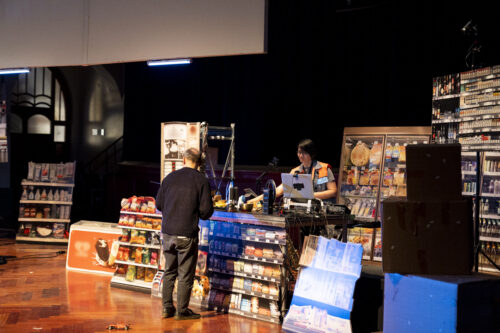
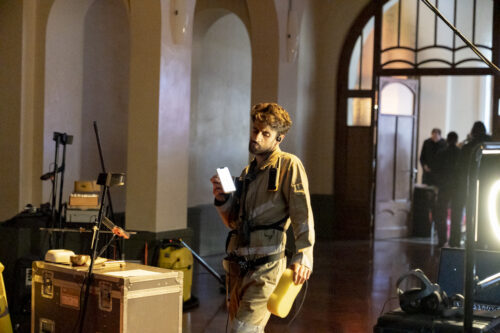
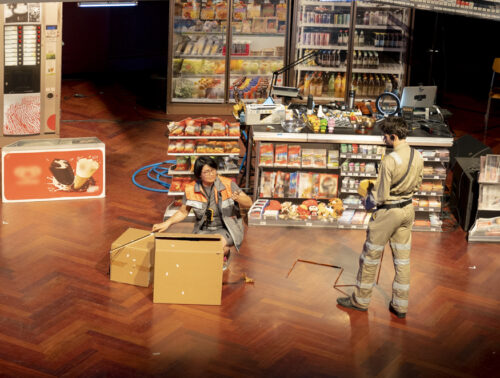
La vidéo tient un rôle important dans la mise en scène?
Plusieurs écrans sont installés au-dessus du décor de carton, qui démultiplient l’espace, modifiant les perspectives scéniques par les effets de zoom de la vidéo live. On assiste également et simultanément à ce qui se trame en dehors de la salle de spectacle, dans les couloirs de la Salle communale de Plainpalais où trône un piano à queue. L’écran multicanal nous invite également à élever les regards et oublier le quotidien grâce au flux immersif d’images ramenant la nature et la forêt qui, dit-on, occupait autrefois l’emplacement de la station-service.
Comment la musique interagit-elle avec le jeu des protagonistes?
L’environnement sonore, les séquences bruitistes voire le concert des instruments font partie intégrante de la narration. Mon aspirateur est aussi générateur de bruit blanc tout comme le pot d’échappement de la voiture en carton qui envoie des jets de fumée. J’ai demandé à un informaticien d’inventer une machine à café qui parle, en dissimulant un échantillonneur qui réagit à la pression des touches. J’aime prendre des objets du quotidien et les transformer. Le mécanicien est aussi aux manettes de la console de projection, l’agent de sécurité, toujours en alerte, manipule des appeaux et nombre de petites percussions, sonnettes, clochettes, bol, petit gong, sont à portée de main de la caissière et des clients qui peuvent en jouer. À certains instants T., les instruments (cor, flûte, saxophone, percussion) s’invitent sur la scène pour un moment musical d’une autre temporalité.
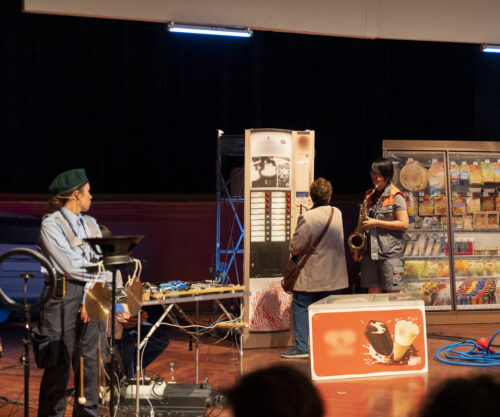
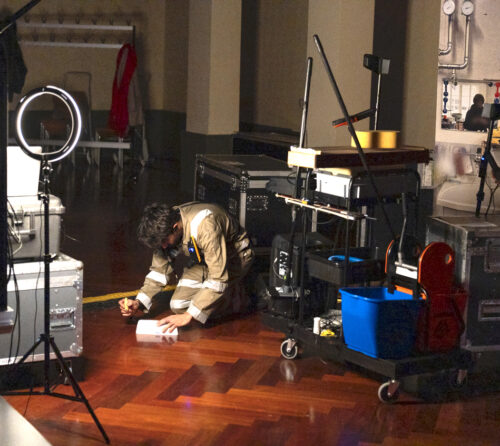

Vous reprenez là votre casquette de compositeur!
Ce sont en effet des partitions que j’ai écrites, mais très en amont du spectacle. Elles répondent toutes à des commandes que j’ai honorées tout en sachant que j’allais les intégrer à mon projet. J’appelle cela des musiques de compilation étant donné que ce sont des pièces déjà existantes qui sont ici réunies. J’avais très envie de faire participer les Neue Vocalsolisten de Stuttgart, ces stars du chant contemporain qu’il était difficile de faire venir sur le plateau. Je suis donc allé les filmer et les enregistrer sur leur lieu de travail. Ils apparaissent en vidéo à la fin du spectacle sur les faces des petits cartons ; ce sont les ghosts de la station-service! Ils portent des casques VR, dont nous avons détourné la fonction habituelle, qui leur permettent de lire la partition en temps réel ; et ils interprètent avec leur verve habituelle quelques chansons de mon cru.
D’envergue wagnérienne, ce grand format de quatre heures semble scandé par des refrains – le doux fredon de la caissière, par exemple – qui donne un suivi et une cohérence à ce récit somme toute très hétérogène. Comment avez-vous pensé la forme de ce spectacle dans sa globalité?
C’est en lisant Chroniques d’une station-service d’Alexandre Labruffe, un roman enchaînant des chapitres très courts dont le contenu donne matière à développement dans le corps du récit, que j’ai eu l’idée de couper les scènes en quatre et de distribuer leurs segments en alternance avec d’autres, assurant au flux du récit une certaine tonicité tout en maintenant une continuité dans la discontinuité.
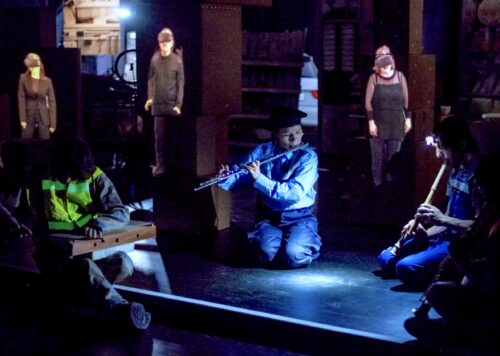
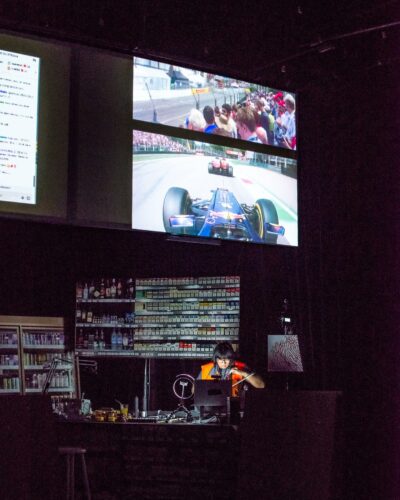
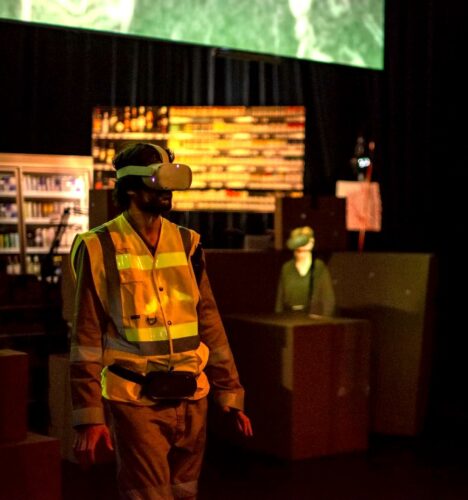
Tous vos spectacles, dites-vous, sont participatifs?
En effet, les spectateurs qui le désirent peuvent intervenir à certains moments et prendre part à l’action via une application à télécharger sur leur smartphone. Ils sont appelés à tour de rôle par la caissière (par des sms), l’un pour aller acheter des cigarettes, l’autre pour prendre un café ou jouer une partie de cymbale ; les textes à dire et les gestes à exécuter défilent sur l’écran de leur téléphone. Ainsi le public est-il, lui aussi, en action, inscrit dans la performance artistique (mon idée était d’ailleurs de les payer pour cela) avec des déplacements constants dans la salle qui brouillent les espaces entre la scène et le public, les acteurs et les écoutants.
Vous ménagez également des moments de théâtre pur…
… à l’adresse du public de théâtre qui vient à nos spectacles et pour inclure une véritable scène humoristique que je scinde également en deux épisodes : il s’agit d’une visio-conférence convoquant derrière les écrans quatre participants lambda et un expert (acteur) dont le discours (sonore lui aussi) adopte les tics de la langue allemande (hm? ja genau, etc.). Sur le modèle des syndicats d’Amazone qui se sont formés tout récemment, j’ai imaginé une réunion où il serait question de fonder des syndicats de stations-service pour apprendre à dire non!
Pourquoi avoir choisi ce mot de Corals (Coraux), renvoyant à la faune marine, que vous accolez à celui de station-service?
Malgré la pression environnementale, l’espèce humaine qui veut toujours plus m’a toujours créé une sorte de malaise (surtout quand on lit des courbes ascendantes de développement et de croissance pour nos activités). Pourtant il semblerait que cette colonisation est propre à chaque espèce, comme celle des coraux (à une autre échelle bien sûr). Aussi les colonies de coraux sont, aux yeux du plongeur que je suis, les endroits les plus intéressants de la mer car ils abritent plein d’autres espèces. Une même ironie s’attache à la station service en plein désert (c’est un endroit accueillant et vivant) et au pétrole (symbole de la station service) permettant à nos colonies de se développer. Sans pétrole, nous ne pourrions pas construire nos villes-coraux. Je crois que je fais ces pièces de musique-théâtre pour me soigner de mes raideurs d’esprit. Malgré moi, je suis bien au piège de mes tristesses liées aux nouvelles bien tristes de l’écologie mainstream. Faire ces recherches me permet de complexifier mes pensées, évitant de prendre les autoroutes habituelles des émotions liées aux gros titres, à la virtualité et à ses divertissements.
Propos recueillis par Michèle Tosi
Photos © Arthur Miserez
Photos © Lea Huser



)


